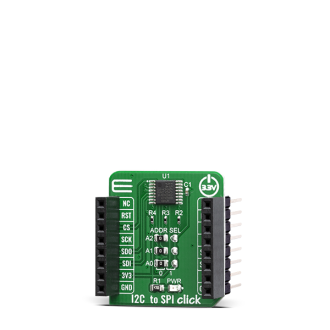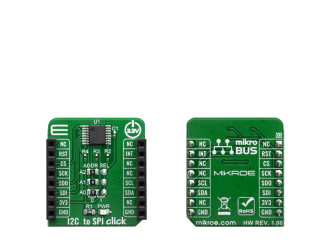
We strongly encourage users to use Package manager for sharing their code on Libstock website, because it boosts your efficiency and leaves the end user with no room for error. [more info]

Rating:
Author: MIKROE
Last Updated: 2019-09-13
Package Version: 1.0.0.0
mikroSDK Library: 1.0.0.0
Category: I2C
Downloaded: 2729 times
Not followed.
License: MIT license
I2C to SPI Click is an all-in-one solution which allows serving as an interface between a standard I2C-bus of a microcontroller and an SPI bus, which allows the microcontroller to communicate directly with SPI devices through its I2C-bus.
Do you want to subscribe in order to receive notifications regarding "I2C to SPI click" changes.
Do you want to unsubscribe in order to stop receiving notifications regarding "I2C to SPI click" changes.
Do you want to report abuse regarding "I2C to SPI click".


Library Description
The library covers all the necessary functions to control I2C to SPI click board. A library performs interface between a standard I2C-bus of a microcontroller and an SPI bus.
Key functions:
void i2ctospi_spiWriteByte( uint8_t slaveDevice, uint8_t functionId, uint8_t regAddr, uint8_t writeData ) - Generic SPI writes the byte of data to data buffer function.uint8_t i2ctospi_spiReadByte( uint8_t slaveDevice, uint8_t functionId, uint8_t regAddr ) - Generic SPI read the byte of data from data buffer function.void i2ctospi_configSPI( uint8_t configData ) - Configure SPI Interface function.Examples description
The application is composed of the three sections :
void applicationTask()
{
timeSeconds = _rtc5GetTimeSeconds();
Delay_1ms();
timeMinutes = _rtc5GetTimeMinutes();
Delay_1ms();
timeHours = _rtc5GetTimeHours();
Delay_1ms();
if ( timeSecondsNew != timeSeconds )
{
mikrobus_logWrite( " Time : ", _LOG_TEXT );
_displayLogUart( timeHours );
mikrobus_logWrite( ":", _LOG_TEXT );
_displayLogUart( timeMinutes );
mikrobus_logWrite( ":", _LOG_TEXT );
_displayLogUart( timeSeconds );
mikrobus_logWrite( "", _LOG_LINE );
mikrobus_logWrite( "------------------", _LOG_LINE );
timeSecondsNew = timeSeconds;
}
Delay_1ms();
}
Additional Functions :
Other mikroE Libraries used in the example:
I2CUARTConversionsAdditional notes and informations
Depending on the development board you are using, you may need USB UART click, USB UART 2 click or RS232 click to connect to your PC, for development systems with no UART to USB interface available on the board. The terminal available in all MikroElektronika compilers, or any other terminal application of your choice, can be used to read the message.